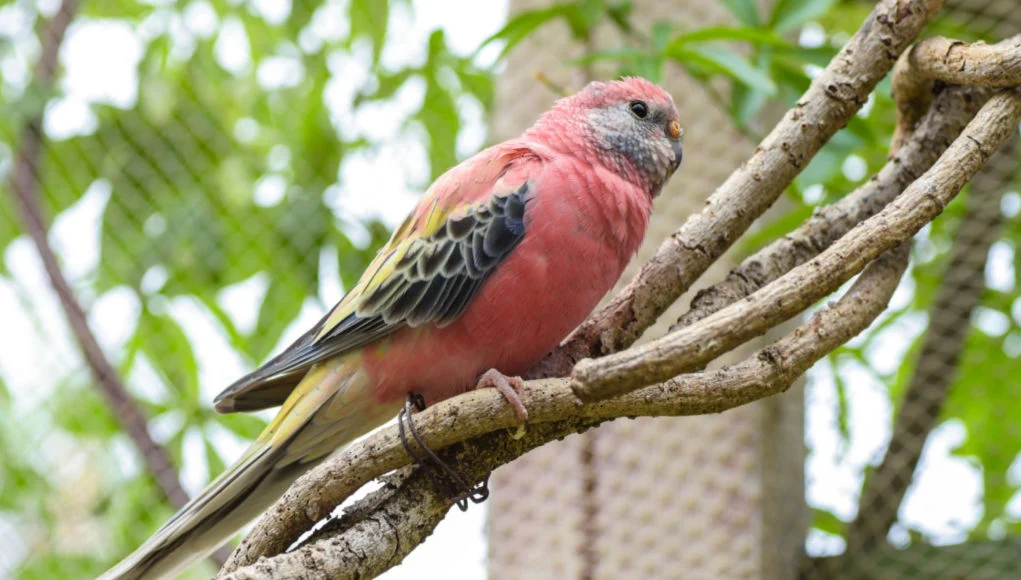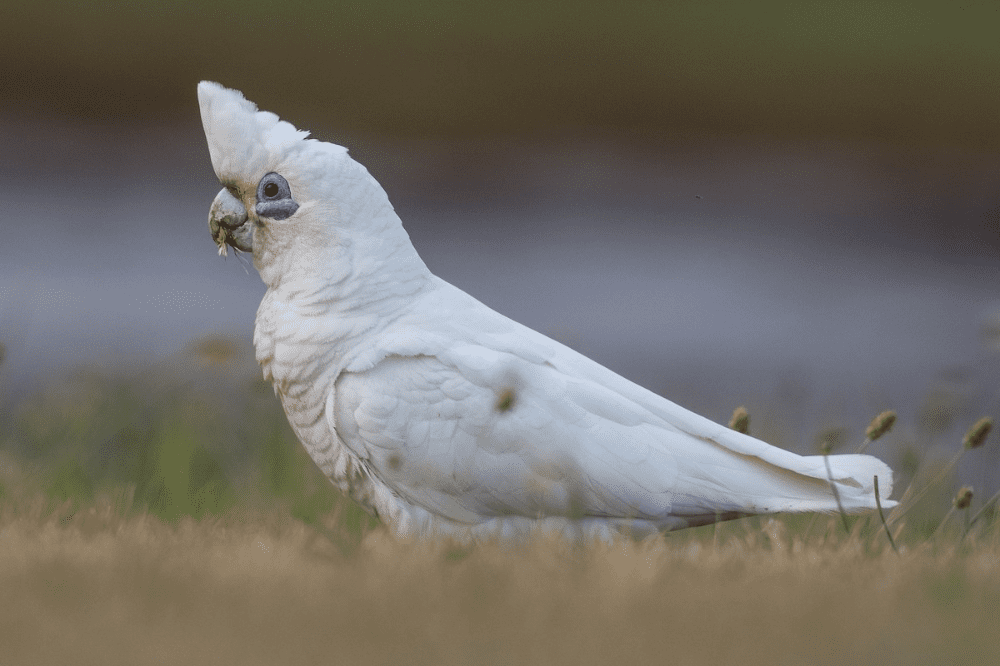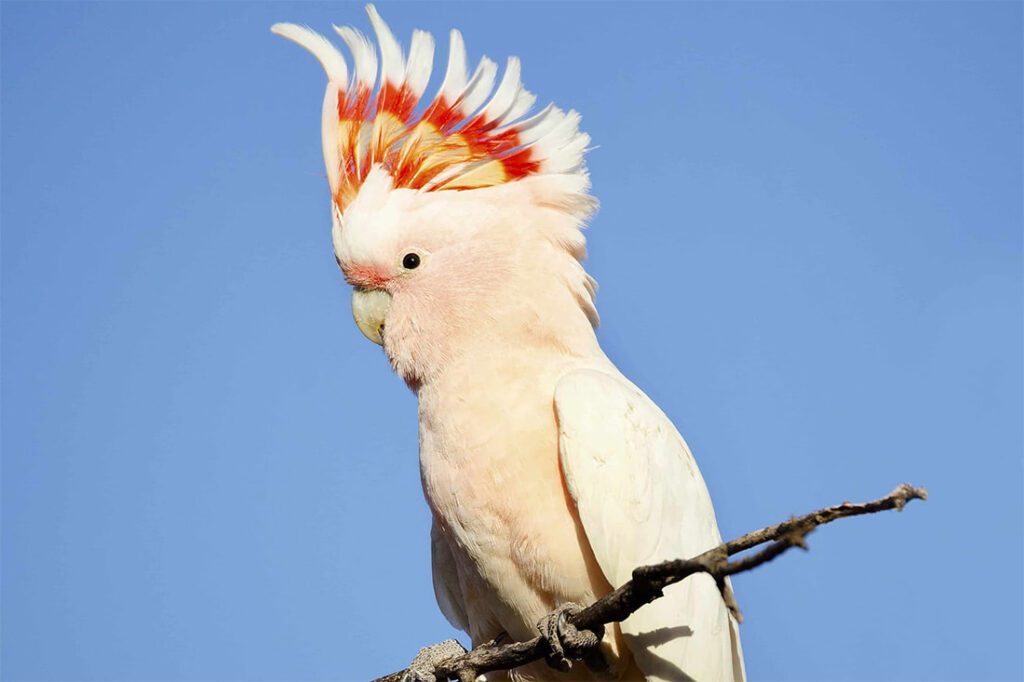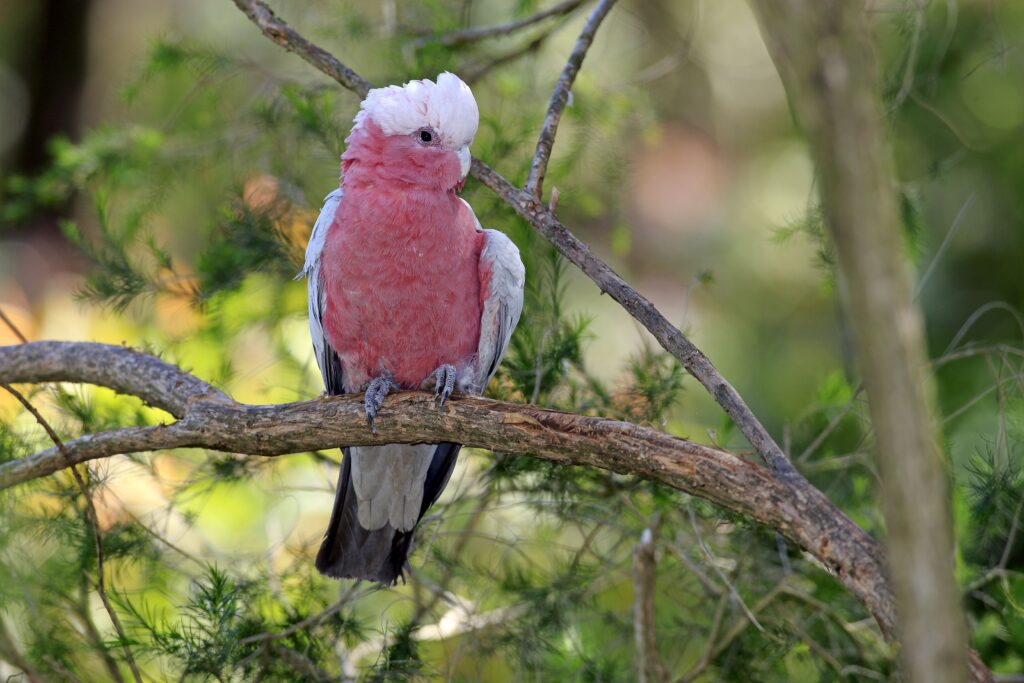Are you ready to dive into a world of vibrant feathers and captivating personalities? Get ready to meet the most fascinating pink parrots that will leave you in awe. From the twilight wanderer, Bourke’s Parakeet, to the vibrant companion, Salmon-Crested Cockatoo, these feathered beauties are anything but ordinary. Join us on this colorful adventure as we uncover the playful acrobat, Little Corella, and the independent beauty, Major Mitchell’s Cockatoo. And let’s not forget the clown of the bird world, Galah Cockatoo. But what’s the secret behind their mesmerizing pink coloration? Stay tuned as we unveil the magic behind this enchanting phenomenon. Get your binoculars ready, because these pink parrots are about to take your breath away!
1. Bourke’s Parakeet: The Twilight Wanderer

bourkes parrot
Among the diverse avian species, the Bourke’s Parakeet, also known as Bourke’s Parrot, is a captivating creature that calls the sunbaked landscapes of Australia home. This enchanting parrot species is a unique spectacle in the animal kingdom, owing to its remarkable plumage that paints a picture of the stunning Australian landscapes.
Their chests and bellies are adorned with hues of romantic blush pink, reminiscent of the breathtaking Australian sunsets. This soft pink transitions into a stark contrast with a dazzling blue rump, evoking images of the endless Australian sky. Their backs are coated with a brownish-grey color, reflecting the vast Australian plains. The Bourke’s Parakeet’s coloration is a stunning tribute to its homeland.
Read more: How Fast Can a Cheetah Run? Unveiling the Secrets Behind Its Incredible Speed
Unlike their parrot brethren who are active during the day, the Bourke’s Parakeet prefers the tranquility of twilight hours. They are the twilight wanderers of the bird world, most active during the serene hours of dawn and dusk. This unique behavior adds an aura of mystery to these already captivating creatures.
Bourke’s Parakeet: Diet and Temperament
The diet of these twilight wanderers primarily consists of seeds, with the occasional insect thrown into the mix. This simple diet is a testament to their adaptable nature and resilience against the harsh Australian climate. The Bourke’s Parakeet’s calm and quiet demeanor is a stark contrast to other parrot species, who are often known for their vibrant sounds and chatter. These parrots are much less demanding, making them an excellent choice for families or first-time bird owners.
Named after Sir Richard Bourke, the Governor of New South Wales from 1831 to 1837, these parrots are the embodiment of peace and tranquility in the avian world.
Bourke’s Parakeet Facts
| Scientific Name | Neopsephotus bourkii |
|---|---|
| Size | 7-8 inches (18-20 cm) |
| Lifespan | 5-8 years |
| Native to | Australia |
| Diet | Seeds, occasionally insects |
| Best suited for | Families, first-time bird owners |
Join us as we continue to explore the fascinating world of pink parrots. Next, we’ll be diving into the vibrant life of the Salmon-Crested Cockatoo.
2. Salmon-Crested Cockatoo: The Vibrant Companion

salmon-crested cockatoo
Stepping straight out of a fairy tale, the Salmon-Crested Cockatoo, often referred to as the Moluccan Cockatoo, is a living piece of art with its sumptuous soft pink plumage that lavishly adorns its body. This fascinating bird species is a sight to behold, painting the air it flies through with strokes of delicate pink.
A key feature that sets this parrot apart is its large, retractable crest. Like a crown, it majestically sits atop its head, adding an extra touch of grandeur to its profile. When extended, it reveals a mesmerizing transition of colors – from a light, blush pink at the base to a vibrant salmon hue at the peak. This crest is not just an aesthetic accessory; it also serves as a powerful communication tool, expressing the bird’s emotions and intentions.
Did you know? The Moluccan Cockatoo is one of the largest cockatoo species and can be incredibly loud. Their screams can be heard up to several miles away!
The Salmon-Crested Cockatoo’s habitat extends to the South Moluccas in eastern Indonesia, where they grace the lowland forests with their enchanting presence. In the wild, their calls echo through the forest, reaching across long distances and serving as a vocal beacon for others of their kind.
As pets, these birds are a bundle of joy but not without their challenges. They are affectionately demanding, seeking constant attention, and forming deep bonds with their human companions. Able to mimic human speech, they are often seen as intelligent and sociable. Their captivating personality and striking appearance make them a popular choice among bird enthusiasts, but their care requires a dedicated and patient owner.
Whether in the wild or in a home, the Moluccan Cockatoo’s vibrant personality and eye-catching coloration make it a truly unforgettable member of the parrot family. As we journey from the twilight wanderings of the Bourke’s Parakeet to the vibrant companionship of the Salmon-Crested Cockatoo, we continue to uncover the fascinating world of pink parrots.
Moving forward, let’s venture into the playful world of another captivating bird – the Little Corella.
3. Little Corella: The Playful Acrobat

little corella
Have you ever chanced upon a parrot performing flips, somersaults, and barrel rolls in the sky? If you have, it’s likely you’ve witnessed the aerial prowess of the fascinating Little Corella, also lovingly referred to as the Bare-Eyed Cockatoo. With its domicile spanning across vast landscapes of Australia and New Guinea, the Little Corella is a delightful member of the pink parrot family, renowned for its playful antics both on the ground and in the air.
The Little Corella’s beauty lies in its subtle elegance. Its plumage is largely white, but a closer look reveals a flush of soft pink on its face, wings, and tail. This light blush contrasts beautifully with the striking blue ring around its eyes, earning this bird its alternate name, the Bare-Eyed Cockatoo. You’ll find these birds flitting through various habitats, from woodlands and grasslands to urban areas, always in search of their next adventure.
When it comes to their social behavior, the Little Corellas are no introverts. They form large, lively flocks and are often seen foraging for food on the ground. Their social interactions are a sight to behold, as they communicate, play, and share food among their group members. They are truly the embodiment of the phrase “the more, the merrier.”
As pets, these birds bring a splash of joy to any household. Known for their intelligence, they bask in problem-solving games and can even learn to mimic speech. While their language abilities may not be as proficient as some of their parrot cousins, their love for interactive play more than makes up for it.
Did you know? The Little Corella is famous for its impressive aerial acrobatics, often seen performing flips and rolls in the air. With a wingspan reaching up to 17 inches, these birds turn the sky into their personal circus!
Whether in the wild or in your living room, the Little Corella, with its playful nature and adorable looks, makes a captivating addition to our list of fascinating pink parrots.
4. Major Mitchell’s Cockatoo: The Independent Beauty

major mitchells cackatoo
Residing in the heart of Australia’s interior, the Major Mitchell’s Cockatoo, or as it is often fondly called, the Pink Cockatoo, stands out in the avian world with its stunning pastel plumage. This beautiful bird, like an artist’s canvas, boasts a sublime mix of white and soft pink hues adorning its body. It’s the vibrant crest, however, that truly steals the show – a dramatic band of red and yellow, akin to a crown of fire, setting it apart from its cockatoo cousins.
Check out: Are Hawks Friendly? Discover the Surprising Truth and Find Out if You Can Keep Hawks as Pets
These birds have adapted to various habitats including woodlands, scrublands, and watercourses, painting a picture of resilience and versatility. In the wild, they partake in a diverse diet, munching on seeds from native shrubs and trees, bulbs, roots, and even insects. This balanced diet contributes to their vibrant plumage and overall health.
Did you know? The Major Mitchell’s Cockatoo is the only cockatoo species where males and females can be distinguished by their eye color. Males adorn dark brown eyes, while females boast reddish-pink eyes. Quite a unique trait for these pink parrots, isn’t it?
As pets, Major Mitchell’s Cockatoos are prized for their beauty, intelligence, and complex personalities. They are more independent compared to other cockatoo species, a trait that can be both a challenge and a reward for bird owners. While they may not be the cuddly type, their engaging personalities and striking appearance make them a joy to observe and interact with.
So, whether you are an experienced bird owner looking for a new feathered friend or a bird enthusiast intrigued by the beauty of pink parrots, the Major Mitchell’s Cockatoo is a species that’s sure to captivate your heart.
5. Galah Cockatoo: The Clown of the Bird World

galah cockatoo
Meet the Galah Cockatoo, a species that adds a splash of brightness to the Australian skies with its flamboyant pink chest and face, and cool gray back and wings. This vibrant bird, also known as the Rose-Breasted Cockatoo, is not just a pretty face. It is a symbol of the Australian spirit, embodying a lively, sociable nature and an affinity for fun.
The Galah Cockatoo’s scientific name, Eolophus roseicapilla, may sound formal, but do not be fooled. These birds are the life of the party in their native habitats which range from the bushlands, forests, to even the bustling urban areas. Their ability to adapt to a variety of environments speaks volumes about their resilience and versatility.
For a Galah, there’s nothing like the company of its own kind. They are often spotted in large, boisterous flocks, their chatter and playful antics creating a spectacle that is both entertaining and heartwarming. It’s no wonder the term ‘galah‘ has become Australian slang for a foolish or clownish person!
As pets, Galahs are a bundle of joy. Their high energy levels and intelligence make them ideal companions for those who appreciate an active, engaging pet. They are quick learners, capable of picking up tricks and commands, and some even mimic human speech. Their playful behavior, combined with their striking appearance, makes them a popular choice among bird enthusiasts. They truly embody the phrase “beautiful inside and out”.
In terms of size, the Galah Cockatoo is quite modest, typically ranging from 12-15 inches (30-37 cm). But do not let their size fool you! Despite their compact bodies, they have a lifespan of 40-70 years, making them a long-term companion for those lucky enough to have them as pets.
So, if you are looking for a bird that brings color, joy, and a touch of the Australian spirit into your life, look no further than the Galah Cockatoo, the clown of the bird world.
6. The Magic Behind the Pink Coloration: Astaxanthin, the Artful Alchemist
Imagine a palette of colors, with brush strokes of soft hues depicting a stunning piece of artistry. This is not a canvas, but the plumage of the pink parrots we’ve been journeying with. The intrigue of their captivating blush coloration is something that has always wowed bird enthusiasts and casual observers alike. So, how do these birds don such a unique color? The secret lies in a pigment known as Astaxanthin, a star member of the carotenoid family.
Astaxanthin, this artful alchemist of nature, is sourced from the parrots’ diet, which predominantly consists of various types of fruits, flowers, and seeds. The parrots’ bodies ingeniously turn these ingested pigments into a paintbrush of sorts. As the feathers grow, the pigments are carefully deposited, resulting in the breathtaking pink hues that define these birds.
Imagine a feather as a blank canvas, with Astaxanthin serving as the artist, meticulously painting each feather with its signature pink hue. The end result? A masterpiece that we admire as the pink parrot.
But the magic of Astaxanthin doesn’t stop there. When light falls on these pigment-deposited feathers, it’s reflected and refracted in a way that adds depth and shine to the pink coloration. It’s this interplay between light and pigment that gives the pink parrots their distinctive, radiant glow.
Now, you might be wondering, is there a purpose behind this pink coloration beyond its aesthetic appeal? Indeed, there is. In the wild, this pink hue can serve as camouflage, helping the parrots blend into environments abundant with pink flowers or during the warm glow of sunsets. Furthermore, a vibrant coloration is often a sign of good health and genetic fitness, making these pink parrots more attractive to potential mates.
In essence, the magic of the pink coloration in parrots is a fascinating blend of diet, biology, and physics, all orchestrated beautifully by nature. It makes you appreciate these birds, doesn’t it? Their captivating hue is not just a feast for our eyes, but a testament to the intricate and stunning artistry of nature itself.
Final Thoughts
As we journey through the vibrant world of pink parrots, we are engulfed in an enchanting spectacle of colors, personalities, and behaviors. The Bourke’s Parakeet, with its gentle twilight hues, and the Galah Cockatoo, with its vivacious demeanor, are more than just fascinating subjects of admiration. They are inimitable embodiments of nature’s boundless creativity and diversity.
Each encounter with these radiant creatures triggers a sense of awe and wonder, an intoxicating fascination that is hard to escape. They paint our world with a splash of color, making our everyday lives a little more enchanting. And it’s not just about their striking pink coloration. It’s about the stories they tell and the emotions they evoke.
We are captivated by their beauty, intrigued by their intelligence, and humbled by their resilience. They are kindred spirits that share our world, each species a testament to the relentless force of evolution and the delicate balance of ecosystems.
“In all things of nature, there is something of the marvelous.” – Aristotle
Preserving the habitats of these pink parrots is imperative. Their existence is woven into the intricate web of life that sustains our planet. Every bird lost is a color faded, a note silenced in the harmony of life. We must strive to protect these vibrant characters and their homes, ensuring their songs continue to fill our skies, and their colors continue to dazzle our eyes.
Our exploration into the world of pink parrots, such as the Bourke’s Parakeet and the Galah Cockatoo, is not the end, but the beginning. There’s a whole spectrum of colorful parrots out there, waiting to be discovered, each with its unique blend of traits and behaviors. The challenge lies not in finding them, but in cherishing their existence and ensuring their survival.
So, let’s keep our hearts open and our minds curious. Let’s continue to explore, appreciate, and protect the fascinating world of parrots. After all, nature has a way of rewarding those who admire its beauty and respect its balance.
Bourke’s Parakeet is a species of pink parrot native to Australia. It is also known as Bourke’s Parrot.
Bourke’s Parakeets have shades of pink on their chests and bellies, blue rumps, and brownish-grey backs. They prefer grasslands, woodlands, and farmlands.
Yes, Bourke’s Parakeets are a great choice for families or first-time bird owners. They have a peaceful and calm demeanor and are not as noisy or demanding as other parrot species.
The standout feature of the Salmon-Crested Cockatoo, also known as the Moluccan Cockatoo, is its large, retractable crest. It changes from a light pink at the base to a bright salmon color at the top when fully extended.

